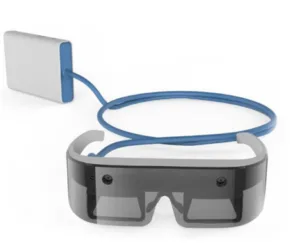Atheer Labs (Mountain View, CA) is one of many companies focused on opportunities in the augmented reality space. Art Berman provided a nice overview of the company back in February (Introducing the Atheer Augmented Reality Glasses), and this article provides an update based on a new interview with the company.
As Art mentioned in his article, Atheer Labs is basically a software company that is developing a hardware platform to showcase what it can do for the augmented reality space. The hardware is a dual-display/dual camera eyeglass device that features technology sourced from partners. The current Augmented interactive Reality (AiR) Smart Glasses device features dual OLED panels with XGA resolution to create a wide 38-40 degree field of view. A next generation device will feature LCOS panels with higher resolution, increased brightness and a larger field of view. Mass production plans have not been announced, but the company has a partnership with Flextronics and is expected to announce something shortly.
The key innovations at the company are centered around two items: a gesture interaction paradigm and – advanced visual ergonomics.
According to Soulaiman Itani, the company CTO, the visual ergonomics feature is like a personal profile of your particular eyes and viewing comforts characteristics. He explained that every person’s eyes are different in terms of separation, spectral response, luminance response, 3D viewing comfort ranges, etc. By measuring all of these and other factors upfront, a profile can be created for every user. “This allows us to customize every image we present to make sure it is always easy to look at and comfortable – something that users of other AR headsets have complained about”.
They call this capability “comfortable visual ergonomics” and it is different than reducing motion artifacts and latency, although these must be eliminated as well.
The other key innovation is a gesture control solution that seeks to provide people with a natural way to interact with the displayed information. That has not really been possible before. Most existing gesture based solutions feature crude movement of hands and arms to perform some very basic interactive commands. “People’s arms actually get tired doing this after awhile”, commented Itani.
Finer gesture movements have been difficult as increasing the resolution of the capture led to heavy power consumption. To reduce power consumption, developers reduced resolution and/or backed off the frame rate. Atheer Labs has solved this trade off with a new solution that allows resolution fine enough for finger accuracy that mimics how you interact with a tablet, but drawing far less power. How much less? Itani didn’t provide any hard numbers, but what he did say was that it will not seriously impact the run time of the AiR Smart Glasses.
These and other features are all rolled up in their AiR OS. This also includes the ability to lock items in the 3D space you are working in. For example, if you are wearing the AiR Smart Glasses and working to repair an engine, you can call up a parts list and place it to the left of your work space while your task list is displayed on the right side. Want to see what the next task is – just turn you head to the right as if the list was on a table next to you.
Ketan Joshi, Atheer Labs’ VP of Marketing, told us more about the applications for the AiR Smart Glasses. “We are seeing good pull from users in the industrial space, oil and gas, healthcare and recent, insurance applications. All of these areas have needs where hands-free access to information is critical”.
He explained that industrial applications include repair and maintenance of high value equipment like turbines, engines and other gear in aircraft and heavy equipment. Oil and gas applications include a variety of field operations again in repair and maintenance.
Healthcare applications include access to patient data and records, especially while in the OR or ER. “We have heard that every time a surgeon has to scrub out of the OR, go check some patient data and scrub back in, it costs the hospital $1500. Any device that can eliminate this expense can be justified pretty easily”, noted Joshi.
Another emerging area is insurance where adjusters can do visual inspections of new properties or damage of existing property, documenting all with the built-in camera or connecting to the home office to discuss something while in the field. This video expert capability has value in all these applications.
Joshi sees these enterprise applications dominating early adoption of AR, but its use will start to grow into the prosumer market in a few years as well.
The company is offering its second generation developers kit now that includes improvements based on user feedback. You can sign up here. – Chris Chinnock


